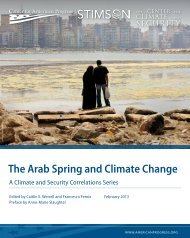Coal Kills
1TndvUf
1TndvUf
You also want an ePaper? Increase the reach of your titles
YUMPU automatically turns print PDFs into web optimized ePapers that Google loves.
While the impact of the emissions from the TPPS are felt within 300km of the stacks, under windy<br />
conditions their influence can be tracked to distances as far as 500km from the source region.<br />
Major cities in the Korba region are Ranchi, Jamshedpur, Rourkela, Jabalpur, Nagpur, and Raipur<br />
(capital of Chhattisgarh); Major cities in the Mundra region are Jamnagar (major industrial port),<br />
Rajkot, and Ahmedabad (300km away, with two TPPs of 1000MW in the city); The city of Delhi<br />
with large TPPs within 100km of radius; experience the impact of the emissions from the coalfired<br />
TPPs, though most of these cities do not host one in their administrative boundaries. The<br />
phenomenon of long range transport of these emissions released at stacks as high as 275m was<br />
illustrated in the form of 24hr forward trajectories, which is currently not accounted in the<br />
environmental impact assessments. The collective impact of the TPPs over each state is<br />
presented in Table 6, as population weighted concentrations, which is indicative of the pollution<br />
load observed in each state, irrespective of the size of the installed capacity in that state.<br />
Table 6: Modelled state average PM 2.5 concentrations (indicative of the<br />
pollution load) due to the emissions from the coal-fired TPPs<br />
2017 2020 2025 2030<br />
Andhra Pradesh 4.9 ± 0.9 (8.5) 6.1 ± 1.1 (9.8) 7.5 ± 1.3 (11.6) 8.4 ± 1.5 (13)<br />
Arunachal Pradesh 1.6 ± 0.3 (2.0) 2.0 ± 0.4 (2.4) 2.5 ± 0.5 (3.0) 2.9 ± 0.6 (3.5)<br />
Assam 2.1 ± 0.3 (2.6) 2.6 ± 0.4 (3.2) 3.3 ± 0.5 (4.1) 3.8 ± 0.6 (4.6)<br />
Bihar 3.7 ± 1 (6.0) 4.3 ± 1.2 (6.5) 5.5 ± 1.7 (7.7) 6.1 ± 1.9 (8.8)<br />
Chhattisgarh 6.6 ± 0.9 (12.7) 8.0 ± 1.0 (14.0) 9.6 ± 1.1 (16.0) 10.6 ± 1.2 (16.9)<br />
Delhi 4.1 ± 1 (5.8) 4.3 ± 1.0 (6.0) 4.7 ± 1.0 (6.4) 5.0 ± 1.0 (6.8)<br />
Goa 3.6 ± 0.1 (3.8) 4.4 ± 0.1 (4.6) 5.4 ± 0.1 (5.6) 6.0 ± 0.1 (6.2)<br />
Gujarat 3 ± 0.7 (5.7) 3.3 ± 0.8 (6.2) 3.9 ± 0.9 (7.0) 4.2 ± 1 (7.5)<br />
Haryana 3.3 ± 0.7 (5.8) 3.5 ± 0.7 (6.0) 3.9 ± 0.8 (6.4) 4.2 ± 0.8 (6.8)<br />
Himachal Pradesh 1.4 ± 0.4 (2.1) 1.5 ± 0.4 (2.2) 1.8 ± 0.5 (2.5) 1.9 ± 0.6 (2.7)<br />
Jammu & Kashmir 0.9 ± 0.2 (1.4) 1.0 ± 0.3 (1.5) 1.2 ± 0.3 (1.8) 1.2 ± 0.3 (1.9)<br />
Jharkhand 5.2 ± 0.7 (10.1) 6.2 ± 0.9 (11.5) 8.0 ± 0.9 (13.3) 8.8 ± 0.9 (14.3)<br />
Karnataka 3.3 ± 0.8 (5.5) 4.1 ± 1.0 (6.4) 5.1 ± 1.2 (7.5) 5.7 ± 1.3 (8.2)<br />
Kerala 1.9 ± 0.2 (2.6) 2.3 ± 0.3 (3.2) 2.9 ± 0.4 (4.0) 3.3 ± 0.4 (4.5)<br />
Madhya Pradesh 3.7 ± 0.9 (8.2) 4.4 ± 1.2 (8.7) 5.2 ± 1.4 (10.0) 5.6 ± 1.5 (10.8)<br />
Maharashtra 4.4 ± 0.9 (9.3) 5.2 ± 1.1 (10.6) 6.3 ± 1.3 (12.1) 6.8 ± 1.4 (12.9)<br />
Manipur 2.4 ± 0.1 (2.6) 2.9 ± 0.1 (3.2) 3.7 ± 0.2 (4) 4.1 ± 0.2 (4.5)<br />
Meghalaya 2.4 ± 0.1 (2.8) 2.9 ± 0.1 (3.3) 3.8 ± 0.2 (4.4) 4.3 ± 0.2 (5.0)<br />
Mizoram 2.5 ± 0.1 (2.6) 3.1 ± 0.1 (3.2) 3.9 ± 0.1 (4) 4.4 ± 0.1 (4.5)<br />
Nagaland 2.1 ± 0.1 (2.4) 2.6 ± 0.2 (2.9) 3.2 ± 0.2 (3.7) 3.7 ± 0.2 (4.2)<br />
Odisha 6.4 ± 0.6 (10.1) 8.1 ± 0.7 (11.5) 10.1 ± 0.9 (13.6) 11.2 ± 0.9 (15.0)<br />
Punjab 1.9 ± 0.3 (2.7) 2.1 ± 0.3 (2.8) 2.4 ± 0.4 (3.2) 2.6 ± 0.4 (3.4)<br />
Rajasthan 2.4 ± 0.6 (6.3) 2.7 ± 0.7 (7.6) 3.1 ± 0.8 (8.1) 3.3 ± 0.8 (8.2)<br />
Sikkim 1.4 ± 0.3 (1.6) 1.7 ± 0.4 (1.9) 2.1 ± 0.5 (2.4) 2.3 ± 0.6 (2.6)<br />
Tamilnadu 2.6 ± 0.5 (5.2) 3.1 ± 0.7 (5.6) 3.9 ± 0.8 (6.3) 4.4 ± 0.9 (6.8)<br />
Tripura 2.6 ± 0.1 (2.8) 3.2 ± 0.1 (3.4) 4.2 ± 0.1 (4.4) 4.7 ± 0.2 (5.0)<br />
Uttar Pradesh 3.2 ± 1.1 (7.4) 3.6 ± 1.4 (8.6) 4.3 ± 1.6 (10.0) 4.7 ± 1.8 (10.8)<br />
Uttarakhand 1.4 ± 0.3 (1.8) 1.6 ± 0.4 (2.0) 1.9 ± 0.4 (2.3) 2.0 ± 0.5 (2.5)<br />
West Bengal 6.0 ± 1.6 (12.9) 7.1 ± 1.9 (14.1) 8.8 ± 2.3 (16.0) 9.7 ± 2.6 (17.0)<br />
The concentrations are in μg/m 3 and the data represents - population weighted state average concentration ± standard deviation of<br />
concentrations for all grids covering the state and (in the brackets - maximum concentration among the grids covering the state)<br />
The model grid size is 0.25 degrees (~25km x 25km). Because of this spatial coverage, these numbers cannot be directly compared to<br />
the data from the monitoring stations, which only represent their immediate vicinity.<br />
19 | <strong>Coal</strong>-fired TPPs in India




